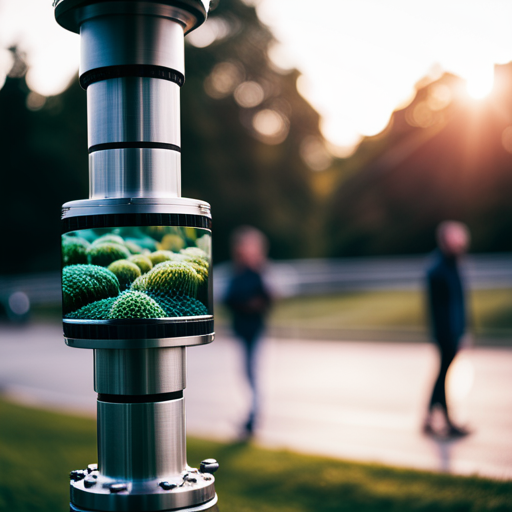Are you curious about the power of autoencoders in the realm of generative AI?
In this article, we will delve into the potential of these remarkable tools. You’ll discover how autoencoders play a crucial role in image, text, and music generation.
Furthermore, we’ll explore how they can be leveraged for real-time video creation.
Get ready to unlock the possibilities of autoencoders in the fascinating world of generative AI.
Key Takeaways
– Autoencoders are neural networks that encode and decode data, generating new data resembling the training data.
– Autoencoders capture underlying structure and patterns in the data, using a latent space to manipulate and combine features.
– Autoencoders allow exploration and control of the generative process, enabling creativity and innovation in image and text generation.
– Autoencoders have the potential to revolutionize text generation and enhance video creation processes, unlocking creativity and innovation in generative AI.
5 Key Concepts of Autoencoders in Generative AI
@ Midjourney AI Image Prompt: /imagine prompt:Create an image featuring an intricate neural network diagram, illustrating the 5 key concepts of autoencoders in generative AI: encoder, decoder, latent space, reconstruction, and loss function. –v 5.2 –ar 16:9
Autoencoders are neural networks that can learn to encode and decode data, making them a key concept in generative AI. When you use autoencoders in generative AI, you can create models that can generate new data that resembles the training data. These models work by learning an efficient representation of the input data and then generating new samples based on that representation.
One important aspect of autoencoders in generative AI is their ability to capture the underlying structure and patterns in the data. By learning to encode the data into a lower-dimensional representation, the autoencoder can capture the most relevant features of the data and discard the noise or irrelevant information. This allows the model to generate new samples that are similar to the training data, but with some variations.
Another key concept of autoencoders in generative AI is the use of latent space. The latent space is the lower-dimensional representation learned by the autoencoder. By manipulating points in the latent space, you can generate new samples that have different characteristics or combine features from multiple samples. This gives you the ability to explore and control the generative process, allowing you to generate new and unique data.
Overall, autoencoders are a powerful concept in generative AI. They allow you to learn the underlying structure of the data and generate new samples that resemble the training data while also giving you the ability to explore and manipulate the generative process.
The Role of Autoencoders in Image Generation
@ Midjourney AI Image Prompt: /imagine prompt:Create an image showcasing a vibrant art piece, where an intricate neural network architecture is depicted as the foundation. Within its layers, vivid abstract patterns emerge, representing the transformative power of autoencoders in generating mesmerizing images. –v 5.2 –ar 16:9
One way to create images is by using autoencoders, which can be trained to learn the underlying features of a dataset and generate new images based on those features. Autoencoders are a powerful tool in the field of generative AI, allowing you to explore the potential of image generation.
Here’s how autoencoders play a crucial role in creating new images:
1. Feature extraction: Autoencoders learn to extract the essential features from an input image, capturing its unique characteristics. This allows them to understand the underlying patterns and structures of the dataset.
2. Dimensionality reduction: By compressing the input image into a lower-dimensional representation, autoencoders reduce the complexity of the data. This not only facilitates storage and processing but also helps in generating new images with fewer parameters.
3. Latent space exploration: Autoencoders map the input image to a latent space, where each point represents a specific feature combination. By navigating this latent space, you can manipulate individual features and generate new images with desired attributes.
4. Generative capabilities: Autoencoders have a decoder component that reconstructs the original input image based on the learned features. By tweaking the latent space variables, you can generate new images that resemble the training data but possess unique characteristics.
Autoencoders provide a powerful framework for image generation, enabling you to explore the latent space and create new images based on the learned features. By understanding the role of autoencoders in generative AI, you can unlock the potential for creativity and innovation in image generation.
Exploring the Applications of Autoencoders in Text Generation
@ Midjourney AI Image Prompt: /imagine prompt:Create an image showcasing a sophisticated neural network architecture, with layers of stacked autoencoders, skillfully reconstructing textual data, and emitting a stream of diverse and coherent text outputs in various styles and languages. –v 5.2 –ar 16:9
To understand how autoencoders contribute to text generation, you can delve into their applications and discover the versatility they offer in creating new textual content. Autoencoders, which are a type of artificial neural network, have found numerous applications in natural language processing tasks such as language translation, summarization, and even creative writing. By leveraging the power of deep learning, autoencoders can learn the underlying patterns and structures in a given text corpus, and then generate new text that adheres to those patterns.
One of the key advantages of autoencoders in text generation is their ability to capture and represent the semantic meaning of words and sentences. This allows them to generate coherent and contextually relevant text. Whether you need to create product descriptions, generate dialogue for chatbots, or even generate poetry, autoencoders can be trained to generate text that is both grammatically correct and semantically meaningful.
To give you a better idea of the applications of autoencoders in text generation, here is a table showcasing some examples:
| Application | Description | Example |
|---|---|---|
| Language Translation | Autoencoders can be used to translate text from one language to another. By encoding the source language and then decoding it into the target language, autoencoders can generate accurate translations. | Encoding: “Hello, how are you?” Decoding: “Bonjour, comment ça va?” |
| Text Summarization | Autoencoders can be trained to summarize long pieces of text into shorter, concise summaries. This can be useful for news articles, research papers, and other forms of lengthy text. | Original text: “The researchers discovered a new species of butterfly in the rainforest.” Summary: “Scientists find new butterfly species in rainforest.” |
| Creative Writing | Autoencoders can also be used to generate creative and imaginative text. By training the model on a large corpus of literature, autoencoders can generate new stories, poems, and even song lyrics. | Generated poem: “The moon shines bright, casting a silver glow. Stars twinkle, like diamonds in the sky. Nature’s symphony plays, as the night unfolds.” |
As you can see, autoencoders offer a wide range of possibilities in the field of text generation. With their ability to understand and generate meaningful text, they have the potential to revolutionize the way we create and consume written content.
Unveiling the Potential of Autoencoders in Music Generation
@ Midjourney AI Image Prompt: /imagine prompt:Create an image that showcases a symphony of overlapping musical notes, where an autoencoder algorithm distills the essence of various melodies into a single harmonious composition, symbolizing the untapped potential of autoencoders in music generation. –v 5.2 –ar 16:9
If you’re interested in music generation, you’ll be amazed by how autoencoders can unleash your creativity and help you compose unique melodies and harmonies.
Autoencoders are a type of generative AI model that can learn the underlying patterns and structures of music and then generate new compositions based on that knowledge. By training an autoencoder on a large dataset of musical compositions, it can learn to encode the input music into a lower-dimensional representation called a latent space.
This latent space captures the essence of the music, allowing the autoencoder to generate new compositions by decoding the latent vectors into melodies and harmonies.
One of the advantages of using autoencoders for music generation is their ability to capture the style and characteristics of a particular composer or genre. By training an autoencoder on the works of a specific composer, you can generate new compositions that are reminiscent of their unique style. Additionally, autoencoders can be used to blend different musical styles together, creating hybrid compositions that are truly one-of-a-kind.
Autoencoders also offer a level of control and creativity in music generation. By manipulating the latent vectors in the latent space, you can explore different musical possibilities and create variations of existing compositions. This allows you to experiment with different melodies, harmonies, and rhythms, resulting in new and exciting musical pieces.
Leveraging Autoencoders for Real-time Video Generation
@ Midjourney AI Image Prompt: /imagine prompt:Create an image showcasing a complex neural network diagram with an encoder-decoder architecture, illustrating real-time video generation using autoencoders. Highlight the intricate connections and transformations involved in leveraging autoencoders for this dynamic process. –v 5.2 –ar 16:9
Are you interested in real-time video generation? If so, then leveraging autoencoders might be just the solution you’re looking for.
Autoencoders are a type of artificial neural network that are widely used in generative AI tasks, including image and video generation. These powerful algorithms can learn the underlying patterns and features of a given dataset and then generate new, realistic video frames in real-time.
By utilizing autoencoders for real-time video generation, you can create dynamic and interactive experiences that were previously only possible with extensive manual effort. Imagine being able to generate personalized video content in real-time, tailored specifically to each user’s preferences and interactions.
Whether you’re working on virtual reality applications, video game development, or even live streaming platforms, autoencoders can provide a valuable tool for enhancing the visual quality and realism of your content.
In addition to real-time video generation, autoencoders can also be used for various other video-related tasks, such as video denoising, video super-resolution, and video compression. The versatility and flexibility of autoencoders make them a valuable asset for anyone interested in pushing the boundaries of video generation and manipulation.
Frequently Asked Questions
How Do Autoencoders in Generative AI Differ From Other Generative Models Like Gans or Vaes?
Autoencoders in generative AI differ from other models like GANs or VAEs because they use an unsupervised learning approach. Autoencoders aim to reconstruct input data, while GANs and VAEs focus on generating new samples.
Can Autoencoders Be Used for Generating Realistic Images With Complex Backgrounds and Multiple Objects?
Yes, autoencoders can be used to generate realistic images with complex backgrounds and multiple objects. They have the potential to capture intricate details and produce high-quality outputs, making them a valuable tool in generative AI.
What Are the Limitations of Using Autoencoders for Text Generation?
Autoencoders have limitations in text generation. You may face challenges in maintaining coherence, grammar, and generating meaningful and diverse output. However, with careful design and training, autoencoders can still be valuable for text generation tasks.
How Can Autoencoders Be Utilized to Generate Music With a Specific Style or Genre?
To generate music with a specific style or genre, you can utilize autoencoders. They can learn the underlying patterns and features of the music and then generate new compositions that match the desired style or genre.
Are There Any Real-Time Video Generation Applications That Have Successfully Leveraged Autoencoders?
Yes, there are real-time video generation applications that have successfully used autoencoders. They have leveraged the power of autoencoders to generate and manipulate videos in real-time, opening up new possibilities in the field of generative AI.
Conclusion
So there you have it, the potential of autoencoders in generative AI is truly remarkable. These AI models have proven their worth in various domains, from image and text generation to music and video generation.
By leveraging the power of autoencoders, we can unlock new possibilities in creating realistic and high-quality content. As technology continues to advance, we can expect even more exciting developments in the field of generative AI with autoencoders at the forefront.
So, embrace this groundbreaking technology and prepare to witness the future of creative AI.



